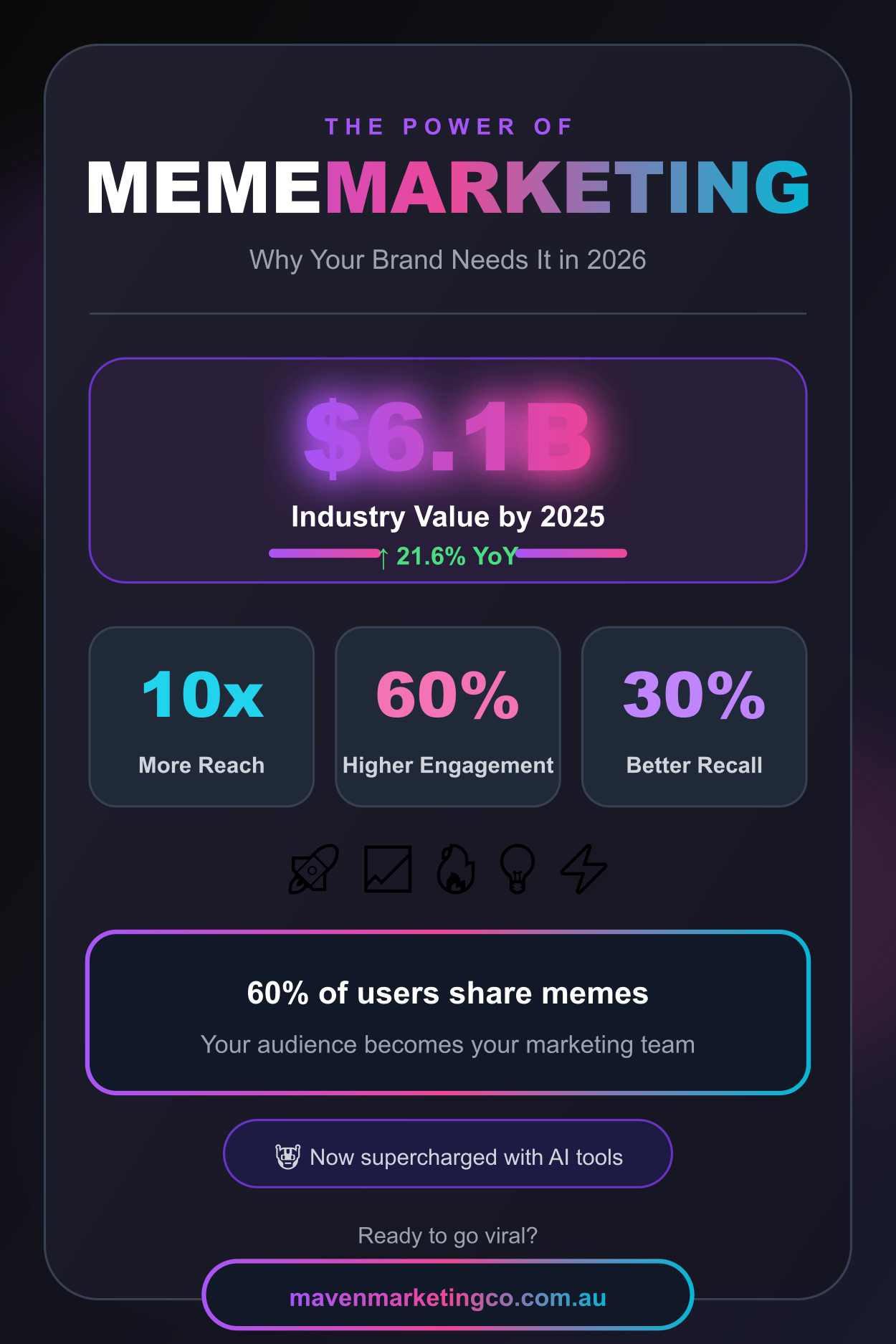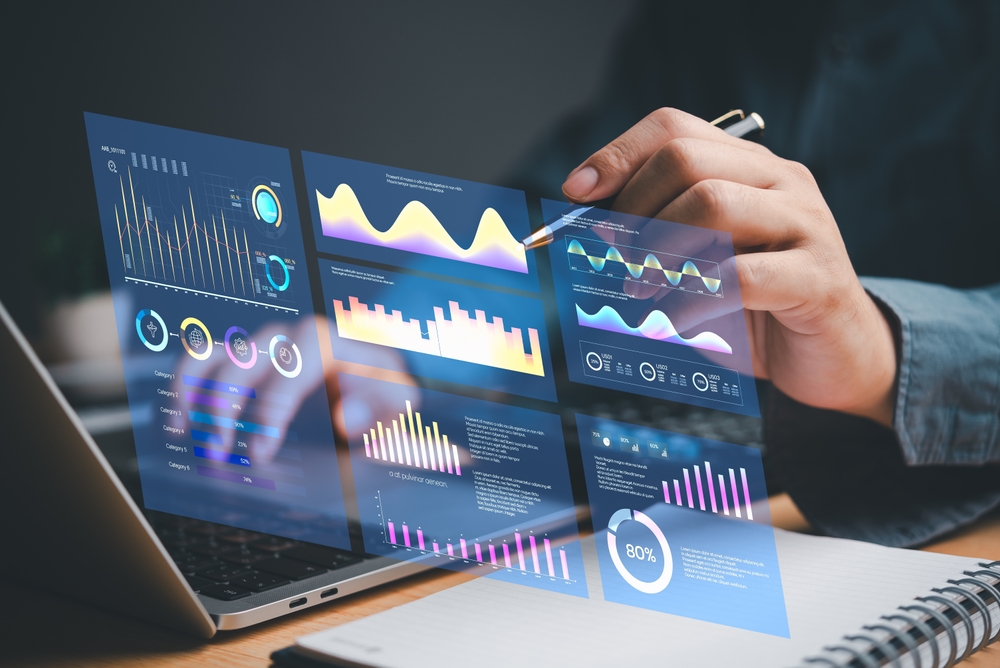
Why the brands winning on social media aren't taking themselves too seriously, and how artificial intelligence is changing the game.
Quick Answers
What is meme marketing and why does it work?
Meme marketing is a digital strategy that uses humorous, relatable image and text formats to promote brands on social media. It works because memes bypass traditional advertising resistance by entertaining rather than selling directly. Research shows meme marketing achieves 10x more reach and 60% higher organic engagement than standard marketing graphics, with 25% increased engagement rates and 30% higher brand recall. The strategy succeeds because 60% of social media users actively share memes, turning audiences into unpaid brand ambassadors.
How can AI help with meme marketing?
AI tools like Supermeme.ai, Imgflip, and MemeCam accelerate meme creation by generating captions, identifying trending templates, and producing on-brand content in seconds. This speed is critical since modern memes have an average lifespan of just four months, down from two years in 2008. However, experts recommend using AI to inspire and draft content rather than fully automating the process. Human oversight remains essential for cultural nuance, timing, and tone—younger audiences can easily detect inauthentic content, which can damage brand reputation.
The Full Guide
Picture this: you're scrolling through your morning feed, half awake, coffee in hand. You pass dozens of polished advertisements without a second glance. Then suddenly, a meme catches your eye. You snort-laugh, screenshot it, and send it straight to your group chat. Within seconds, you've become an unpaid brand ambassador—and you didn't even realise it.
Welcome to the wild, wonderful world of meme marketing, where humour meets strategy and virality is the ultimate currency.

The Rise of the Meme Economy
What was once dismissed as frivolous internet fodder has evolved into a legitimate marketing powerhouse. The global meme industry was valued at approximately $2.3 billion in 2020 and is projected to reach a staggering $6.1 billion by 2025representing an annual growth rate of 21.6 percent. That's not just impressive; it's a seismic shift in how brands communicate with their audiences.
The numbers tell a compelling story. Meme marketing campaigns achieve a 14 percent higher click-through rate compared to traditional email marketing. Even more striking, research indicates that memes generate ten times more reach and 60 percent higher organic engagement than standard marketing graphics. In an age where consumers have developed sophisticated defences against traditional advertising, memes slip past these barriers through humour, relatability, and the appearance of authenticity.
But here's the kicker: 60 percent of social media users actively share memes. With over 5.24 billion people now active on social platforms globally, representing nearly 64 percent of the world's population, the potential reach is astronomical. One million memes are shared daily on Instagram alone. The question isn't whether your brand should be creating memes—it's whether you can afford not to.
Why Humour Hits Different
The psychology behind meme marketing's effectiveness is fascinating. Unlike traditional advertising, which consumers have learned to tune out, memes operate on an entirely different wavelength. They tap into shared experiences, cultural moments, and that delicious feeling of being "in on the joke."
Think about it: when did you last share a banner advertisement with your mates? Probably never. But a perfectly-timed meme about the Monday morning struggle? That's getting sent to every colleague you have.
Memes work because they're fundamentally human. They acknowledge our collective anxieties, celebrate our absurdities, and give us permission to laugh at the chaos of modern life. When brands can authentically participate in that conversation—rather than awkwardly interrupting it—magic happens.
Generation Z and Millennials in particular have an almost preternatural ability to detect inauthentic content. A meme that feels forced or out-of-touch can do more harm than good. But when brands get it right? The rewards are extraordinary. Brands incorporating memes into their strategy have seen a 25 percent increase in engagement and up to 30 percent higher recall rates compared to traditional advertisements.

The Brands Getting It Brilliantly Right
Several companies have mastered the art of meme marketing, transforming their social media presence into must-follow entertainment.
Duolingo stands as perhaps the most spectacular example of this approach. The language-learning app's green owl mascot has evolved from a simple notification reminder into a full-blown internet icon. The brand leans into the running joke that Duo will "hunt you down" if you miss your lessons, creating content so delightfully unhinged that people actively seek it out. Their TikTok strategy—focused on entertaining rather than selling—has helped drive a 62 percent increase in daily active users.
Wendy's revolutionised brand Twitter with their savage, no holds barred approach to social media. Their willingness to roast competitors (and occasionally their own customers) created a personality that feels more like a witty friend than a fast food chain. The strategy contributed to a reported 49.7 percent growth in profit, proving that bold personality pays dividends.
Netflix masterfully turns its own content into shareable moments, creating memes from iconic scenes that fans eagerly spread. By leaning into fan culture and user-generated content, they've built a community that markets for them.
What unites these brands isn't just humour but courage. They've abandoned the safety of corporate speak in favour of authenticity, and their audiences have rewarded them handsomely.
Enter AI: Your New Creative Co-pilot
Here's where things get particularly interesting for Australian businesses looking to compete in this space. Artificial intelligence is democratising meme creation, making it faster and more accessible than ever before.
Platforms powered by GPT models and visual AI can now generate clever captions, identify trending meme templates, and produce on-brand humour in seconds. Tools like Supermeme.ai, Imgflip, and MemeCam are enabling marketers to respond to trending topics almost instantaneously—a critical advantage when meme relevance is measured in hours rather than days.
The speed factor cannot be overstated. The average lifespan of a modern meme has shrunk dramatically—from nearly two years in 2008 to approximately four months today. That window is closing fast, and AI tools help brands strike while the iron is hot.
But here's the crucial caveat that separates successful AI assisted meme marketing from cringeworthy disasters: AI should inspire, not automate. These tools excel at generating drafts, identifying trending formats, and accelerating production. However, the human touch remains non-negotiable.
Internet users, especially younger demographics, can spot inauthentic content from a kilometre away. AI doesn't understand nuance, context, or the subtle cultural currents that make a meme truly resonate. It can't tell when a joke has crossed from clever to offensive, or when a trend has already peaked. That requires human judgement, cultural fluency, and genuine understanding of your audience.
The winning formula? Use AI to expand your creative possibilities and speed up production, then apply human oversight to refine tone, timing, and taste.

Building Your Meme Marketing Strategy
Ready to bring some humour to your social media presence? Here's how to approach it strategically:
Know your audience intimately. What makes them laugh? What frustrations do they share? What cultural references will resonate? Memes that work for Gen Z won't necessarily land with Baby Boomers, and what kills in Melbourne might fall flat in Perth. Understanding your audience's language, pain points, and sense of humour is foundational.
Stay culturally literate. Subscribe to trending accounts, set up Google alerts for viral content, and dedicate time to actually scrolling through social media. The best meme marketers are students of internet culture, constantly absorbing what's resonating and why.
Act fast but think carefully. Timing is everything in meme marketing. A perfectly relevant meme posted two weeks late is worse than no meme at all. However, speed shouldn't come at the expense of sensitivity. Always research a meme's origins and current context before associating your brand with it.
Be subtle with branding. The most effective marketing memes feel like jokes first and promotions second (if at all). Heavy-handed branding kills virality. Trust that entertainment creates affinity, which creates customers.
Choose your platforms wisely. Instagram and Twitter remain ideal for static meme content. TikTok dominates for video-based humour. LinkedIn? Yes, actually—work-related humour performs surprisingly well among professional audiences. Match your meme style to each platform's culture.
Embrace authenticity over polish. Interestingly, deliberately low fi memes that look like they were made in MS Paint often outperform slick productions. This aesthetic signals authenticity and reinforces relatability. Don't overthink the production value.
The Risks Worth Knowing
Meme marketing isn't without pitfalls. Forced humour, cultural missteps, and tone deaf timing can generate negative attention that far outweighs any potential benefit. Brands must thoroughly research a meme's origins before incorporating it into campaigns, as social media trends can conceal political or offensive contexts.
There's also the shelf life challenge. Overusing memes exhausts audiences, and failed attempts often generate mockery. The goal is to participate in culture, not desperately chase it.
Finally, legal considerations matter. Many memes use copyrighted images without explicit permission. While enforcement in the meme space remains relatively relaxed, brands should be mindful of potential intellectual property issues.
The Bottom Line
Meme marketing in 2025 isn't a gimmick but rather a legitimate, data backed strategy for building community and boosting brand visibility. When executed with cultural fluency, authentic voice, and strategic timing, it can achieve what traditional advertising increasingly cannot, which is genuine connection with audiences who have learned to ignore everything else.
The brands thriving in today's digital landscape aren't the ones with the biggest budgets. They're the ones that understand culture, speak fluently in internet language, and aren't afraid to make their audiences laugh.
The future of meme marketing will likely involve increasingly sophisticated AI tools that personalise content for specific demographics. But at its core, the power won't change because it's about making people feel seen, heard, and part of something bigger.
So, what's your meme strategy for 2025?
Ready to Make Your Brand Unforgettable?
At Maven Marketing Co, we understand that modern marketing demands more than clever taglines. It requires genuine cultural connection. Our team combines strategic expertise with creative flair to help Australian businesses cut through the noise and build authentic relationships with their audiences.
Whether you're ready to dive into meme marketing, need a complete social media strategy overhaul, or simply want to explore how humour can humanise your brand, we're here to help you craft campaigns that resonate, engage, and convert.
Let's start a conversation about your brand's next chapter









